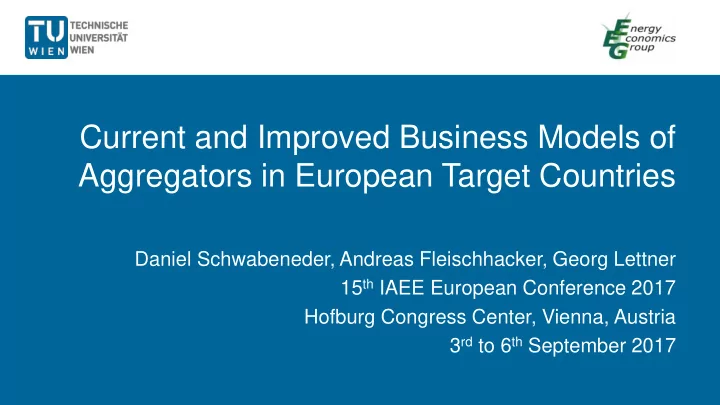

Current and Improved Business Models of Aggregators in European Target Countries Daniel Schwabeneder, Andreas Fleischhacker, Georg Lettner 15 th IAEE European Conference 2017 Hofburg Congress Center, Vienna, Austria 3 rd to 6 th September 2017
This work is part of the BestRES project: Best practices and implementation of innovative business models for Renewable Energy Aggregators This project has received funding from the European Union’s Horizon 2020 research and innovation programme under grant agreement N°691689. 05/09/2017 2
“Aggregation” and “Aggregators” as defined in BestRES Aggregation: “ a coordinated steering of vast amounts and types of consumers and producers ” Aggregators: “ legal entities that aggregate the load or generation of various demand and/or generation/production units and aim at optimizing energy supply and consumption either technically or economically ” 05/09/2017 3
Methodology of BestRES How do we find improved business models? 1 st step: Analyzing current business models (BM) for aggregators 2 nd step: Improving BM in a qualitative way Focus of this 3 rd step: Analyzing improved BM in a presentation quantitative way 4 th step: Implementation and monitoring of improved business models 05/09/2017 4
Qualitative Business Model analysis via the BM Canvas Key Partner Key Activities Value Customer Customer Proposition Relation-ships Segments Key Channels Resources Cost Structure Revenue Stream 05/09/2017 5
Selected example: Current Business Model for Next Kraftwerke Germany Next Kraftwerke Germany is a Combined Aggregator and Balance Responsible Party in Germany. They are pooling decentralized generators (PV, Wind, Biogas, Biomass CHP) and customers (commercial, industrial) for marketing on the day-ahead spot market and various reserve markets. The key assets are control systems, computer models, forecast algorithms and administration knowledge. Value is generated by offering balancing services and optimal scheduling of electricity generation, trading and consumption. 05/09/2017 6
Selected Example: Improved Business Models for Next Kraftwerke Germany Supplying „mid -scale “ consumers with time variable tariffs including grid charges optimization Provide flexible customers with price signals (already implemented) Consider other tariff components like grid charges in the optimization algorithm. 05/09/2017 7
Cost components of a electricity consumer Energy supply Grid charges Fixed annual component [EUR/a] Energy-dependent component [EUR/MWh] Peak-load pricing component [EUR/MW] (for the maximum load per year/month) Fees 05/09/2017 8
Model and scenarios For the quantitative evaluation of the potential of the improved BM a linear mixed-integer optimization model has been implemented. It minimizes the cost for purchasing energy for flexible loads from the day-ahead spot market Three scenarios are compared: Baseline (no optimization) Spot (optimization considering the market prices only) Grid (optimization considering both market prices and grid charges) Both, an annual and a monthly peak-load pricing component are considered for the grid charges 05/09/2017 9
Loads Three different loads of consumers connected to the medium voltage network are considered Three different gird tariffs (MITNETZ STROM, Westnetz, Netze BW) are considered for the loads 05/09/2017 10
Flexibility options The loads can be changed flexibly according to price signals with the following restrictions: A load reduction/increase has to last for at least 3 hours. There has to be a pause of at least 1 hour between to flexibility activations. The load reduction/increase has to be between 0.1 MW and 0.3 MW. Maximally 2 load reductions and increases are allowed per day. Load reductions/increases are only allowed on weekdays The total daily consumption may not be changed by the flexibility activations. 05/09/2017 11
Results with annual peak-load pricing Load 2 has its highest load at a time where the flexibility must not be active. 05/09/2017 12
Results with annual peak-load pricing 05/09/2017 13
Results with monthly peak-load pricing 05/09/2017 14
Complete Business Model analysis (outlook) A certain share of the customer cost reduction can be the Aggregator‘s revenue in this business model. For a complete analysis this has to be compared to the additional cost of optimally managing demand response of customers loads: Costs for software development Costs for data metering and billing If the additional cost is lower than the customers cost reduction this is an improved Business Model, where both, the aggregator and the customer can benefit. 05/09/2017 15
Conclusions: For both, annual and monthly peak-load pricing tariffs, the improved business model can increase the Aggregator‘s revenue (by up to 8% of the original customers electricity cost for the analyzed loads). The load characteristics have to be taken into account for the implementation of this business model. It has to be noted that these results are optimal with perfect foresight of prices and loads. Real life algorithms do not have this kind of information. This is work in progress. In the future additional costs need to be taken into account and other business models have to be analyzed in detail. 05/09/2017 16
D ANIEL S CHWABENEDER Technische Universität Wien Institute of Energy Systems and Electrical Drives Energy Economics Group – EEG Gußhausstraße 25-29 / E370-3 1040 Vienna, Austria [P] +43 1 58801 370 375 [E] schwabeneder@eeg.tuwien.ac.at [W] www.eeg.tuwien.ac.at
Recommend
More recommend